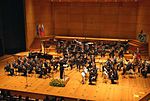Socialist Republic of Slovenia

The Socialist Republic of Slovenia (Slovene: Socialistična republika Slovenija, Serbo-Croatian: Socijalistička Republika Slovenija / Социјалистичка Република Словенија), commonly referred to as Socialist Slovenia or simply Slovenia, was one of the six federal republics forming Yugoslavia and the nation state of the Slovenes. It existed under various names from its creation on 29 November 1945 until 25 June 1991. In early 1990, the government dismantled the single-party system of government – installed by the League of Communists – and adopted a multi-party democracy. Republic of Slovenia dropped the 'Socialist' label shortly after and in late 1990 cast a successful public vote for independence, which it formally declared on 25 June 1991 and achieved after the brief Ten-Day War.
Excerpt from the Wikipedia article Socialist Republic of Slovenia (License: CC BY-SA 3.0, Authors, Images).Socialist Republic of Slovenia
Trg republike, Ljubljana Trnovo
Geographical coordinates (GPS) Address Nearby Places Show on map
Geographical coordinates (GPS)
| Latitude | Longitude |
|---|---|
| N 46.05 ° | E 14.5 ° |
Address
Trg republike
Trg republike
Ljubljana, Trnovo
Slovenia
Open on Google Maps







